back to
Legends of Hollywood
One of the longest and most popular series issued by the U.S. Post Office, these 21 sheets issued between 1995 and 2016 honor some of the most popular and influential actors, actresses and directors of the 20th century who have had a major impact on the development of American cinema. Each sheet of 20 features a large illustrated margin with a portrait and short biography. From the suave Cary Grant and blonde bombshell Marilyn Monroe to tough guys Humphrey Bogart, James Cagney and Edward G. Robinson, these sheets will delight any movie buff.
Marilyn Monroe
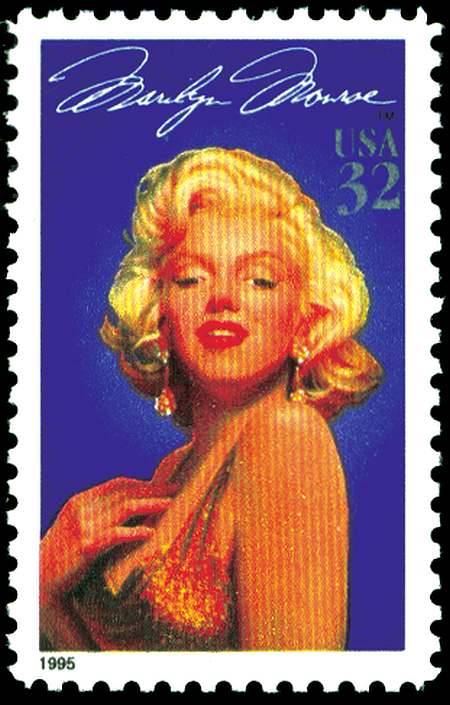 1995-commems-2587-3023/2967-32-marilyn-monroe-57049 1995-commems-2587-3023/2967-32-marilyn-monroe-57049 |
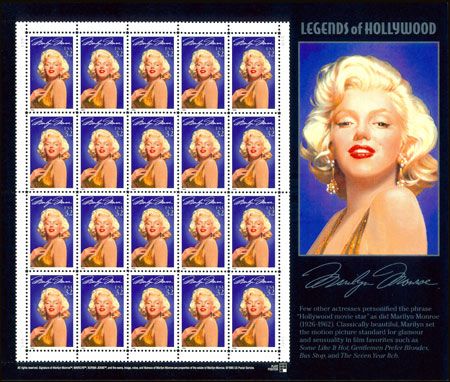 2967s-32-marilyn-monroe-mint-2967sm 2967s-32-marilyn-monroe-mint-2967sm |
|
The original sex symbol and blonde bombshell, Marilyn Monroe (1926-1962) found success as a singer, model and actress from the early 1950s through the early 1960s. Although she captivated the public and pushed the boundaries of what was considered sensible and appropriate for the time, Marilyn had many personal demons, and tried to silence them with drugs and alcohol. Conspiracy theories abound surrounding her personal life and death from barbiturate overdose, but she will always remain the iconic American blonde bombshell. (US #2967)
James Dean
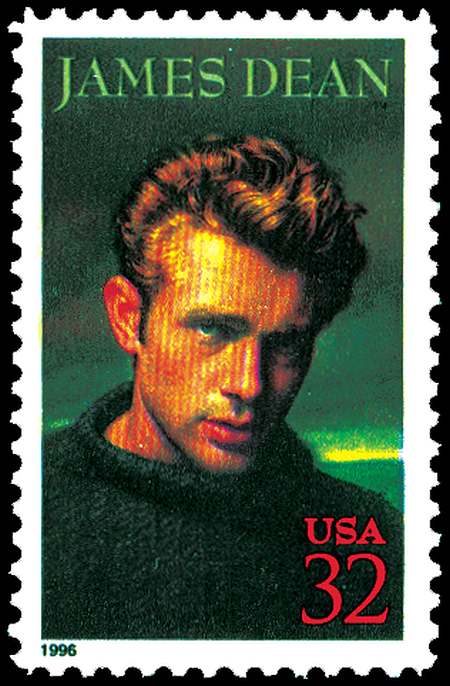 3082-32-james-dean-57168 3082-32-james-dean-57168 |
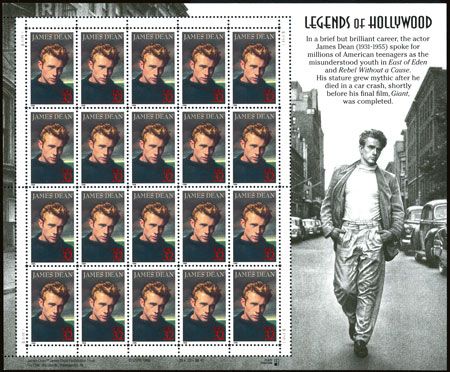 3082s-32-james-dean-mint-3082sm 3082s-32-james-dean-mint-3082sm |
|
James Dean (1931-1955) is remembered as a cultural icon of teenage disillusionment and social estrangement, as he portrayed in his most famous film, "Rebel Without a Cause". Starring in only three films, he was first noticed by the public in a series of acclaimed television plays. As one who led a fast life on and off screen, he was interested in developing a career in auto racing. Unfortunately, his brief career came to an end when he died of injuries sustained in an auto accident at the age of 24. (US #3082)
Humphrey Bogart
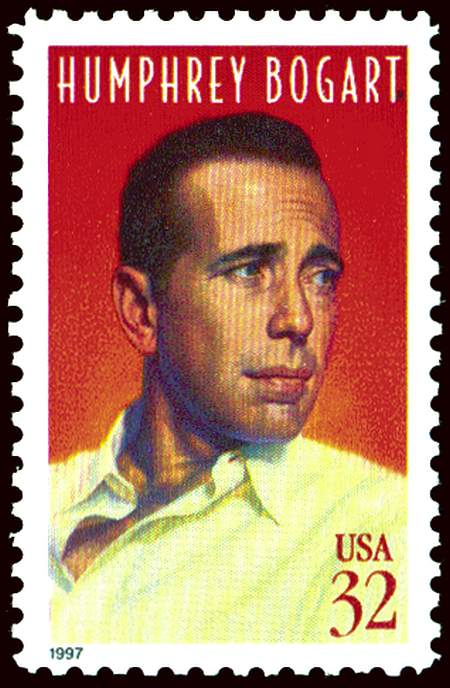 3152-32-humphrey-bogart-57243 3152-32-humphrey-bogart-57243 |
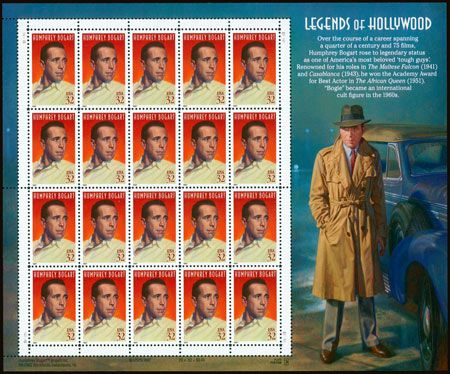 3152s-32-humphrey-bogart-mint-3152sm 3152s-32-humphrey-bogart-mint-3152sm |
|
Capable of playing a tough guy, romantic lead, and comic roles with equal ease, Humphrey Bogart (1899-1957) starred in over 70 movies in a 35-year career. In 1999 the American Film Institute selected him as the greatest male star of American cinema. While he was first chosen to play gangster roles due to his resemblance to John Dillinger, his breakthrough came in 1941 with starring roles in "High Sierra" and "The Maltese Falcon", and his role as Rick Blaine in 1942's "Casablanca" alongside Ingrid Bergman helped make it one of the greatest films of Hollywood's golden age. (US #3152)
Alfred Hitchcock
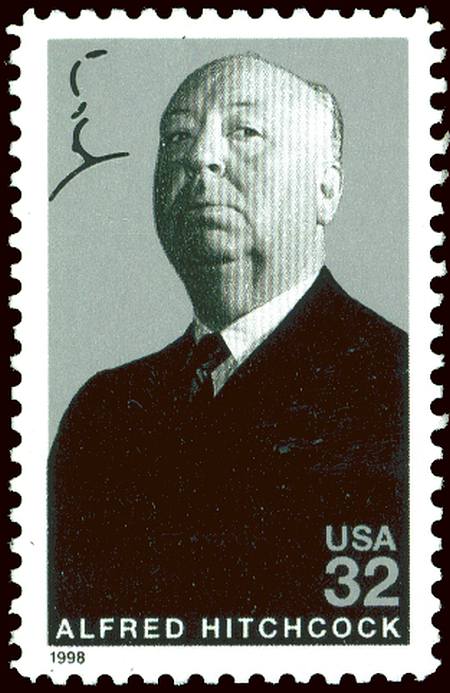 3226-32-alfred-hitchcock-57331 3226-32-alfred-hitchcock-57331 |
 3226s-32-alfred-hitchcock-mint-3226sm 3226s-32-alfred-hitchcock-mint-3226sm |
|
Called one of the most influential and studied film directors in the history of cinema, Alfred Hitchcock (1899-1980) is one of the few film directors to be as famous in front of the camera as behind it. Directing over 50 films in a career spanning six decades, Hitchcock was known for his brief cameo roles in his films, and his droll, deadpan delivery and gallows humor made his long-running tv series "Alfred Hitchcock Presents" one of the most popular shows of its time. He was knighted in 1980, just a few months before his death at the age of 80. In 2012 the British Film Institute named his 1958 film "Vertigo" the greatest film ever made, based on a worldwide poll of film critics. (US #3226)
James Cagney
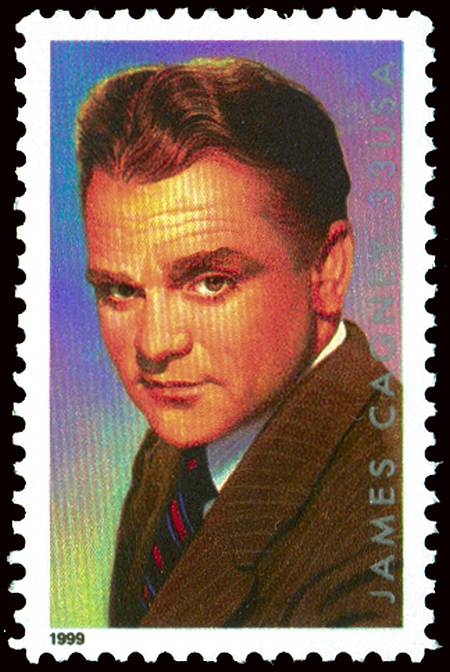 3329-33-james-cagney-57442 3329-33-james-cagney-57442 |
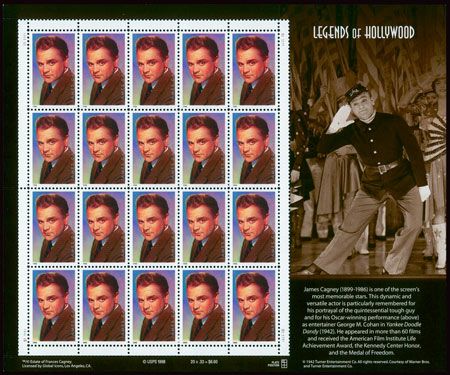 3329s-33-james-cagney-mint-3329sm 3329s-33-james-cagney-mint-3329sm |
|
One of the most versatile actors of Hollywood's golden age, James Cagney (1899-1986) was known for his energetic performances, whether it was a musical, comedy or crime drama. While he was often typecast as a tough guy in films such as "The Public Enemy" and "White Heat", his skills as a dancer landed him the role of George M. Cohan in 1942's "Yankee Doodle Dandy" for which he won an Academy Award. Orson Welles once called Cagney "maybe the greatest actor who ever appeared in front of a camera". (US #3329)
Edward G. Robinson
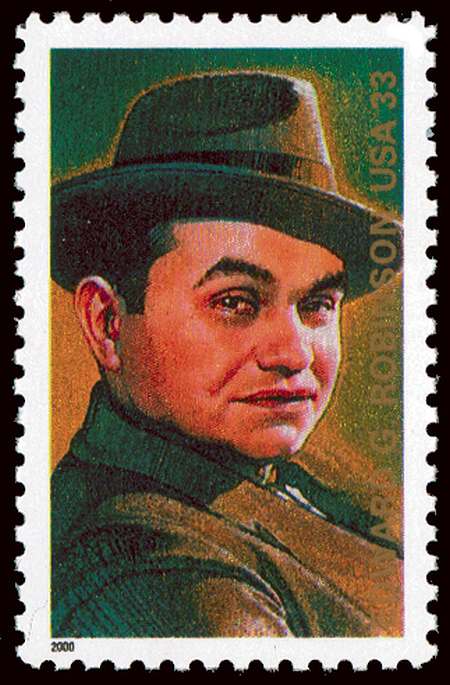 3446-33-edward-g-robinson 3446-33-edward-g-robinson |
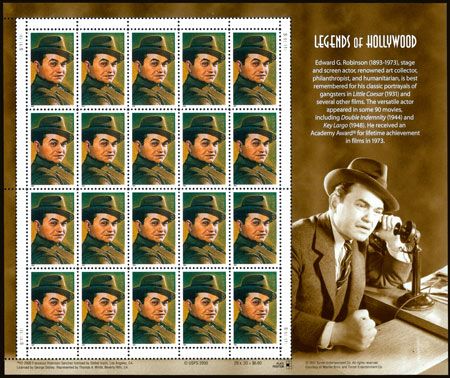 3446s-33-edward-g-robinson-mint-3446sm 3446s-33-edward-g-robinson-mint-3446sm |
|
Born Emanuel Goldenberg in Bucharest, Edward G. Robinson (1893-1973) appeared in more than 40 Broadway plans and 100 films in a 50-year career. While he is best remembered for tough guy roles in films such as "Little Caesar" and "Key Largo", he was also an outspoken critic of fascism and Nazism and contributed over $250,000 to over 850 organizations involved in relief during World War II. While he was too old to enlist in the military, the Office of War Information appointed him a Special Representative based in London, where he used his multilingual skills to deliver radio messages to citizens in occupied nations. The American Film Institute ranks Robinson 24th on its list of the 25 greatest male stars of Classic American cinema. (US #3446)
Lucille Ball
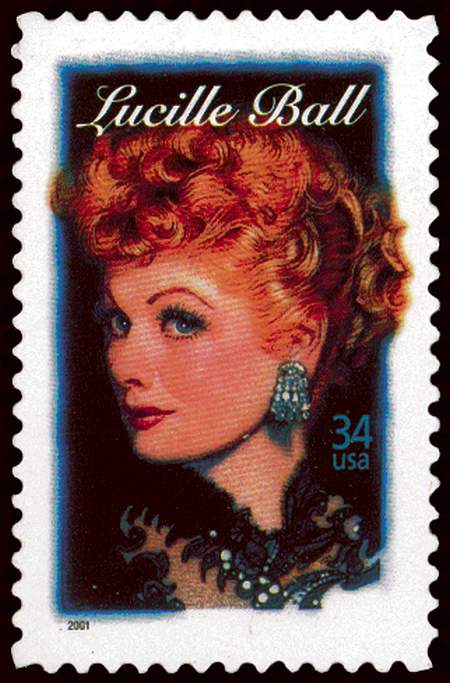 3523-34-lucille-ball 3523-34-lucille-ball |
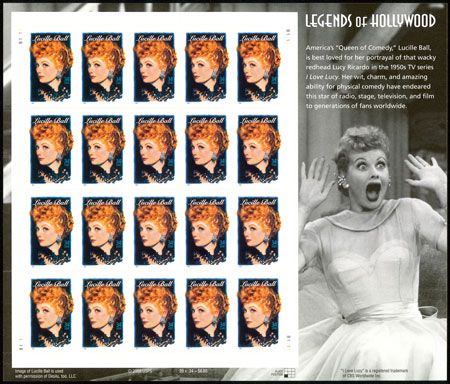 3523s-34-lucille-ball-mint-3523sm 3523s-34-lucille-ball-mint-3523sm |
|
Known mainly for her comedic role in "I Love Lucy", one of the most beloved television shows of all time, Lucille Ball (1911-1989) was also a gifted stage actress, producer and fashion model. She was the first woman to run a major television studio, Desilu Productions, which produced many popular television series including "Star Trek" and "Mission: Impossible". In 1989 she posthumously received the Presidential Medal of Freedom. (US #3523)
Cary Grant
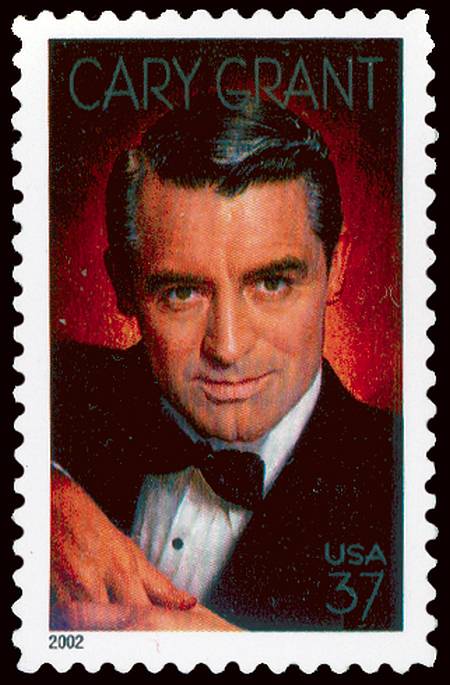 3692-37-cary-grant 3692-37-cary-grant |
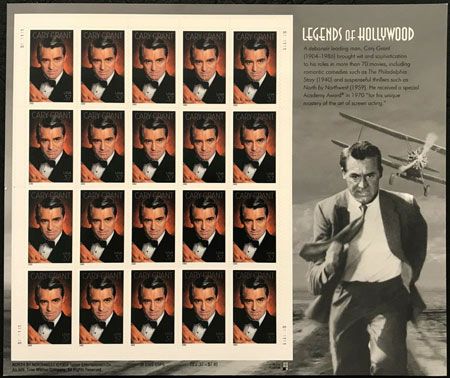 3692s-37-cary-grant-mint-3692sm 3692s-37-cary-grant-mint-3692sm |
|
Born in England as Archibald Leach, Cary Grant (1904-1986) is considered one of Hollywood's greatest leading men. Known for his cultivated English accent, suave looks, debonair demeanor, comedic timing and light-hearted approach to dramatic roles, he was a top box office attraction in a career spanning over 30 years and 70 films. He was a favorite of director Alfred Hitchcock, and starred in four Hitchcock films. In 1989 the American Film Institute named Grant the second greatest male star of Golden Age Hollywood, second only to Humphrey Bogart. (US #3692)
Audrey Hepburn
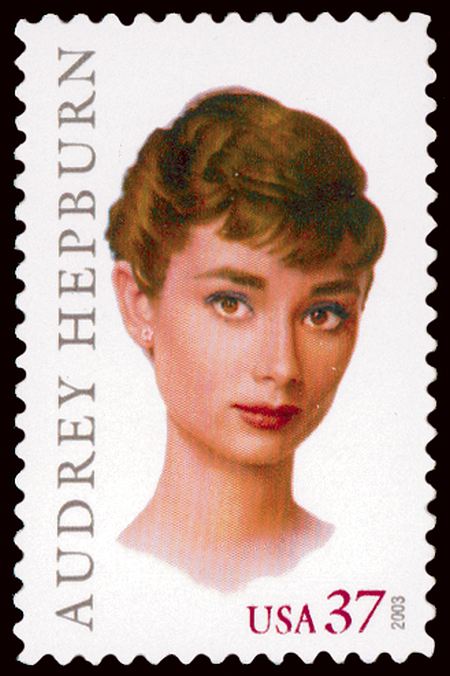 3786-37-audrey-hepburn 3786-37-audrey-hepburn |
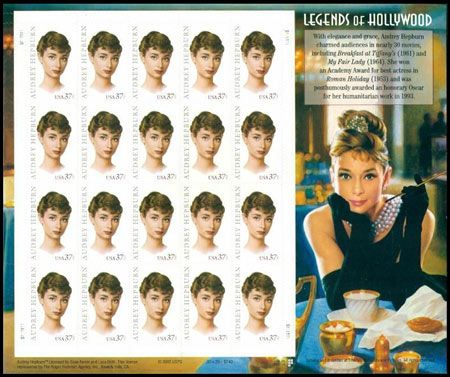 3786s-37-audrey-hepburn-mint-3786sm 3786s-37-audrey-hepburn-mint-3786sm |
|
Known for her fashion choices and distinctive look, Audrey Hepburn (1929-1993) was born in Brussels and began her career performing in ballet and as a chorus girl. She rose to stardom in 1953's "Roman Holiday" alongside Gregory Peck, and was the first actress to win an Oscar, Golden Globe and BAFTA Award for a single performance. Her role as a Cockney flower seller in "My Fair Lady" is considered the best of her career. In her spare time she was a Goodwill Ambassador for UNICEF and received the Presidential Medal of Freedom for her work. (US #3786)
John Wayne
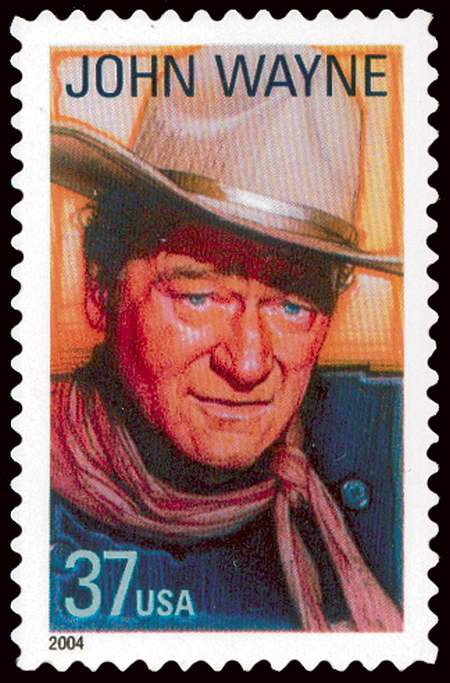 |
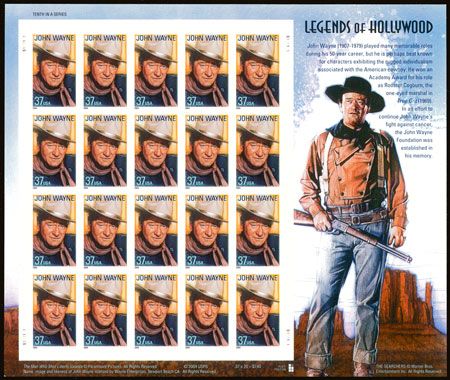 |
|
Perhaps no actor typifies American cinema more than John Wayne (1907-1979). Known as "The Duke", Wayne appeared in over 170 films in a career spanning six decades. Standing 6'4" tall, Wayne's break came in the 1930 western "The Big Trail", and it was 1939's "Stagecoach" that made Wayne a top box office attraction. While primarily known for his westerns, Wayne's larger than life image worked well in leadership roles that symbolized American values and ideals. His enduring status as an iconic American earned him two of the nation's highest civilian decorations: the Congressional Gold Medal and the Presidential Medal of Freedom. (US #3876)
Henry Fonda
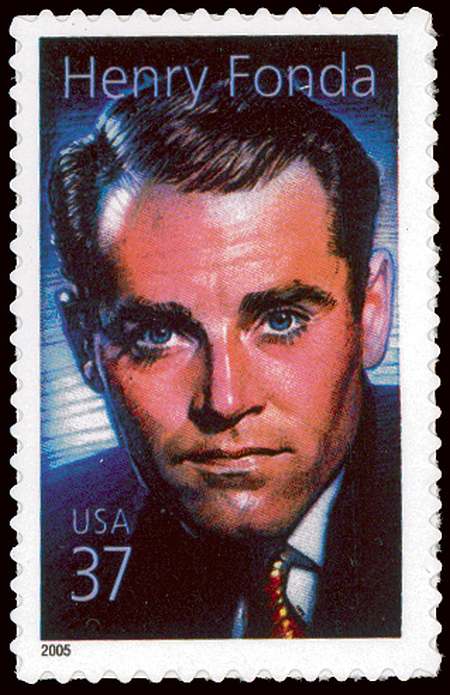 |
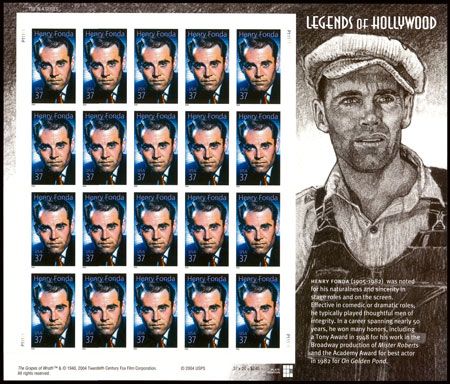 |
|
| US #3911 Sheet |
Recognized as one of the greats of Hollywood's golden age, Henry Fonda (1905-1982) often played quintessential American heroes known for their integrity. In a career spanning from 1935 to 1981, Fonda starred in more than 90 films, portraying roles as varied as a young Abraham Lincoln, the dispossessed farmer Tom Joad in "The Grapes of Wrath", and a navy officer in the comedy "Mister Roberts". He won numerous awards throughout his career, including the Best Actor Oscar for his final role as a crusty retiree in "On Golden Pond". (US #3911)
Judy Garland
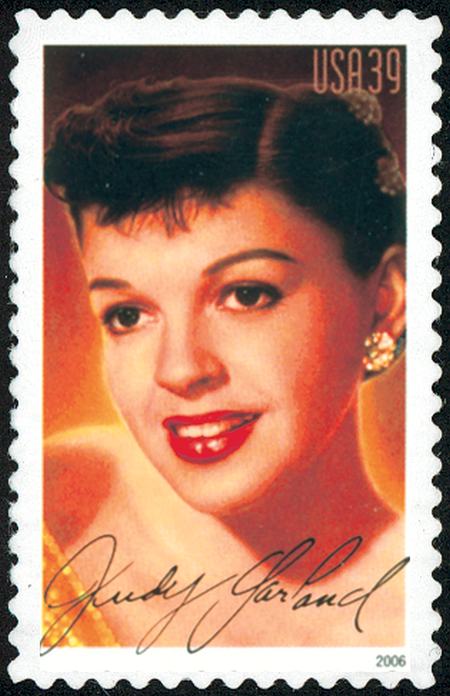 |
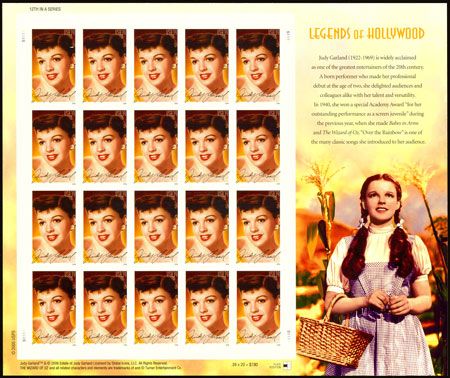 |
|
Born Frances Gumm, Judy Garland (1922-1969) grew up in a family of vaudevillians and began her movie career with MGM as a teenager. Appearing in more than two dozen films for MGM, she is best remembered for her role as Dorothy in 1939's "The Wizard of Oz", and was a frequent on-screen partner of Mickey Rooney and Gene Kelly in musicals. She released 8 studio albums, her concert appearances were sellouts, and her television variety show received an Emmy Award. At the age of 39 she became the youngest recipient of the Cecil B. DeMille Award for lifetime achievement. Sadly, the pressures of stardom led to her dependence on drugs and alcohol and she died of an accidental drug overdose at the age of 47. (US #4077)
James Stewart
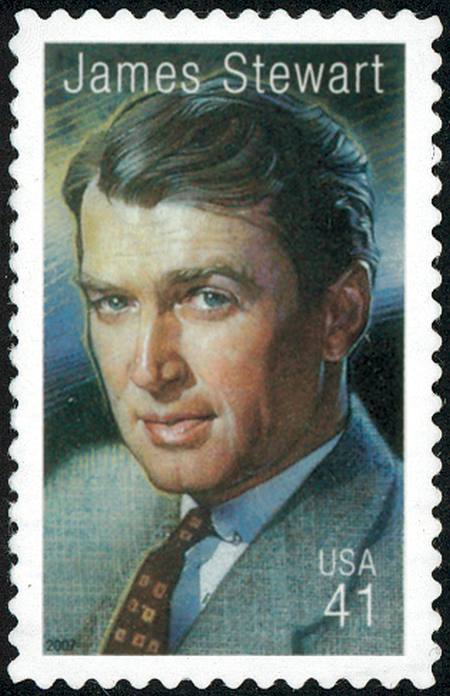 |
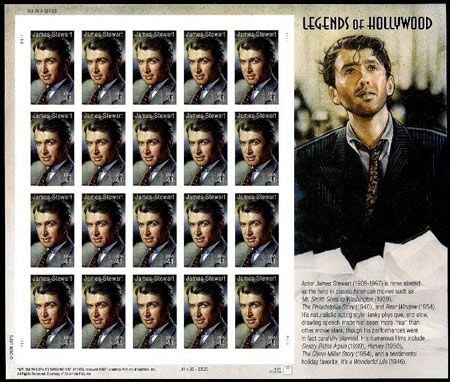 |
|
James "Jimmy" Stewart (1908-1997) is one of the most honored and popular stars in film history. Known for his distinctive drawl, down-to-earth personas and relaxed "everyman" acting style, Stewart had a film career that spanned over 55 years and more than 80 pictures, many of which are considered classics. Both on and off screen Stewart epitomized the American ideal, and his emotional film performances contributed to his cinematic acclaim. Stewart served as a pilot during World War II, rising to the rank of Brigadier General, the highest-ranking actor in American history, and in 1985 he was awarded the Presidential Medal of Freedom by Ronald Reagan. (US #4197)
Bette Davis
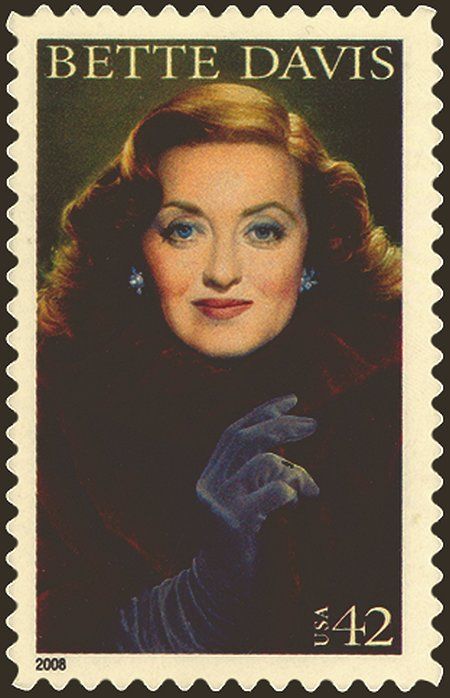 |
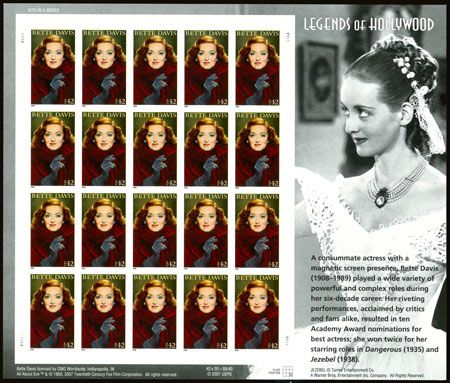 |
|
With a career spanning more than 60 years and 100 acting credits, Bette Davis (1908-1989) is considered one of the greatest actresses in Hollywood history. After a brief career on Broadway, her breakthrough came as a vulgar waitress in 1934's "Of Human Bondage", and in 1935 she won an Academy Award for best actress on "Dangerous". Known for playing forceful and unsympathetic characters, she often sought roles as manipulators and killers in an era when actresses usually preferred to play sympathetic characters. She received many awards throughout her career, including being the first woman to receive the American Film Institute Lifetime Achievement Award, and was the first person to receive five consecutive Academy Award nominations for acting. (US #4350)
Bob Hope
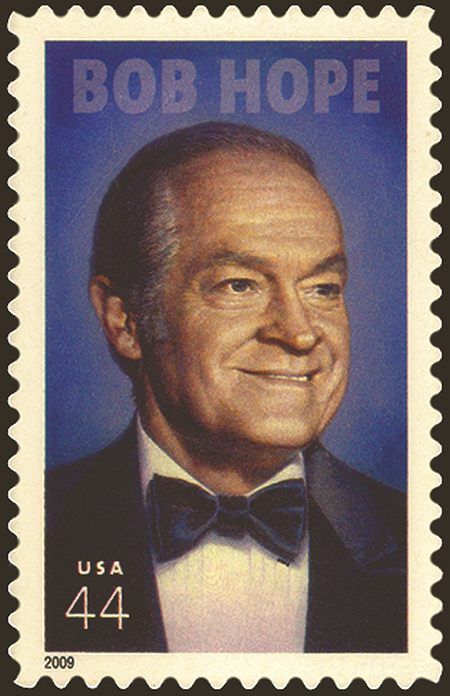 |
 |
|
Born in England as Leslie Townes Hope, Bob Hope (1903-2003) is not officially part of the "Legends of Hollywood" stamps, but is unofficially included in the series because of the similar sheet layout and the fact that Bob Hope is one of the most popular, generous and successful entertainers of all time. In a career spanning more than 80 years, Bob Hope starred in 54 feature films, appeared in numerous stage and television roles, performed standup comedy to sold-out audiences, starred in a top-rated radio show, hosted the Academy Awards 19 times, and as a member of the USO, entertained our troops for 50 years on 57 tours. As an avid golfer, he played in up to as many as 150 charity tournaments a year. Hope received more than 2000 awards during his life, including a Congressional Gold Medal from President Kennedy and the Presidential Medal of Freedom from President Johnson for his work with the USO. (US #4406)
Gary Cooper
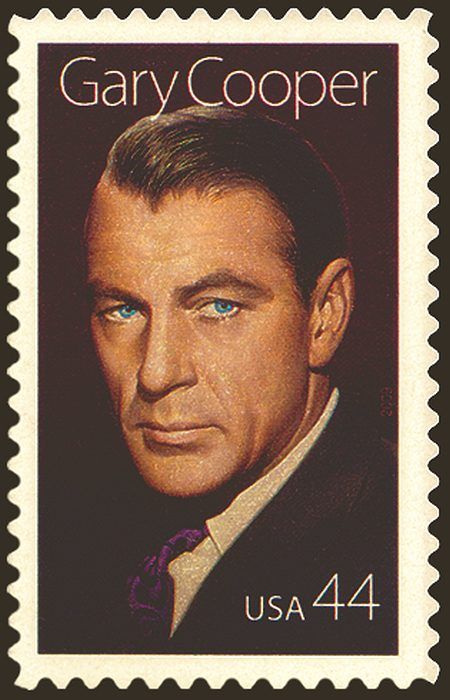 |
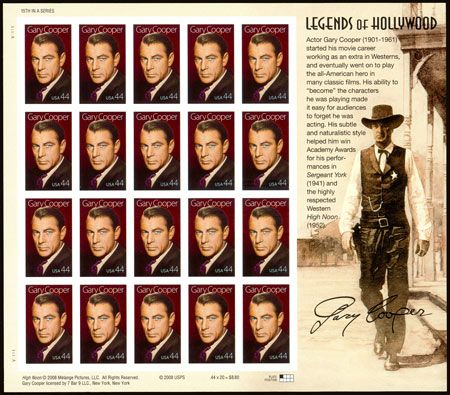 |
|
Beginning his film career with silent films, Gary Cooper (1901-1961) starred in 84 films from 1925 to 1961. Known for his understated, natural acting style, his screen persona represented the ideal American hero. He began his career as a stuntman and extra, but soon landed acting roles often in westerns and later expanded to dramas, comedies and adventure films. Cooper once said "You find out what people expect of your type of character and then you give them what they want. That way, an actor never seems unnatural or affected no matter what role he plays." He received numerous awards including Academy Awards for his roles in "Sergeant York" and "High Noon". (US #4421)
Katharine Hepburn
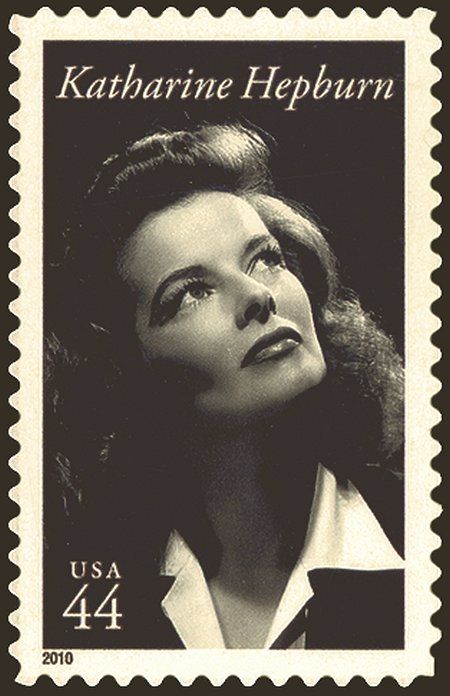 |
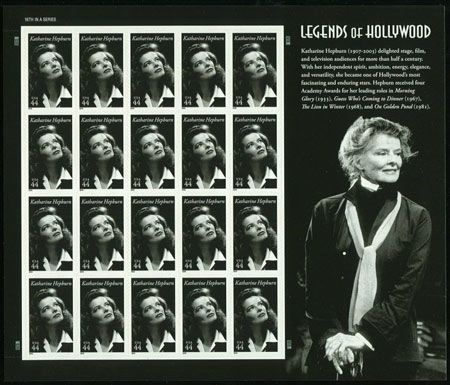 |
|
Known for her fierce independence and spirited personality both on and off screen, Katharine Hepburn (1907-2003) was a leading lady in Hollywood for more than 60 years. Appearing in everything from screwball comedies to serious dramas, she received a record four Academy Awards for lead acting roles, and in 1999 was named the greatest female star of Classic Hollywood Cinema by the American Film Institute. Beginning her acting career in college, her work on Broadway brought her to the attention of Hollywood, and by the time of her third picture "Morning Glory" (1933) she received a best actress Oscar. In the 1940s she began a romantic partnership with Spencer Tracy which spanned 26 years and 9 movies. Today she is considered an important and influential cultural figure, and off screen her independent lifestyle came to symbolize the modern woman, changing attitudes not only in traditional gender roles but in fashion as well. (US #4461)
Gregory Peck
 |
 |
|
With his rugged good looks and deep voice, Gregory Peck (1916-2003) was one of the most popular leading men from the 1940s to 1960s. While attending medical school, he was encouraged by an acting coach to try acting, and appeared in several plays at UC Berkeley and before finishing his degree, he headed to New York to study acting. He made his Broadway debut in 1942 and appeared in his first film, "Days of Glory", in 1944. He broke Hollywood tradition by not signing an exclusive contract with one studio, giving him the freedom to choose his roles and landing him prominent leading roles. In 1962 he received an Academy Award for his role as small-town lawyer Atticus Finch in "To Kill a Mockingbird", considered the finest role of his career. Peck received the Presidential Medal of Freedom in 1969 for his humanitarian work. (US #4526)
Charlton Heston
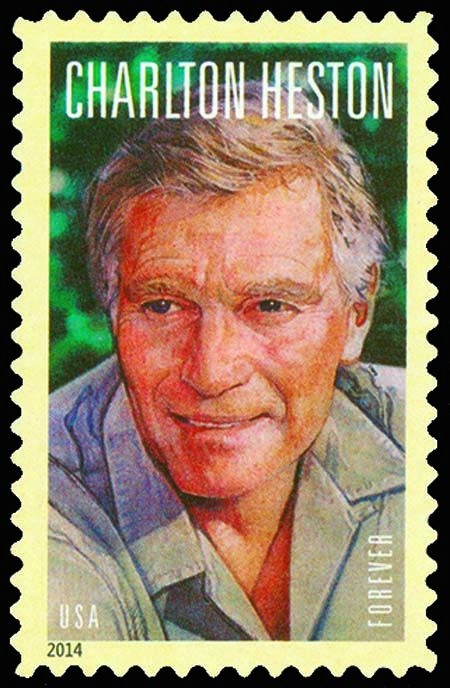 |
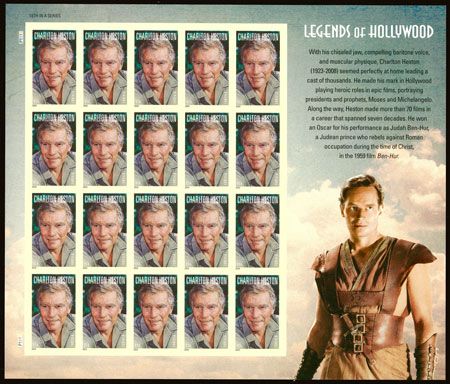 |
|
Born John Charles Carnet, Charlton Heston (1923-2008) made his name as both an actor and a political activist as head of the National Rifle Association. In a career of over 60 years, Heston appeared in almost 100 films and won an Academy Award for best actor in the 1959 film "Ben-Hur". In 1944 Heston joined the Air Force and served two years aboard a B-25 bomber. Following the war, he decided to revive his interest in acting and appeared in several Broadway plays, and a 1949 television play brought him to the attention of Hollywood, and he appeared in his first film in 1950. His role as Moses in the 1956 biblical epic "The Ten Commandments" was highly praised, making him a desirable heroic lead in action pictures. (US #4892)
Ingrid Bergman
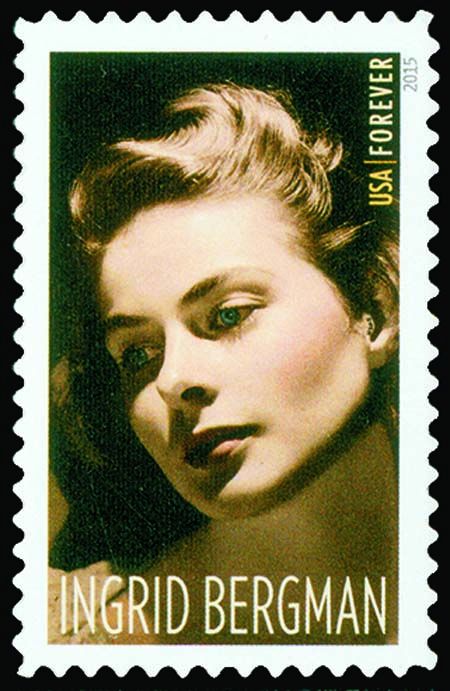 |
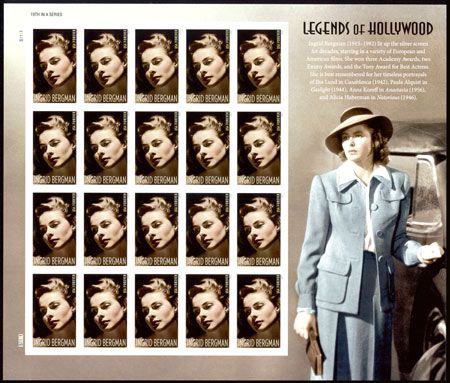 |
|
Ingrid Bergman (1915-1982) began her acting career in her native Sweden and made her debut to American audiences in a 1939 English-language remake of "Intermezzo" which she had originally made in Sweden in 1936. The enormous success of "Intermezzo" made her a star, and she soon appeared opposite Hollywood's top leading men including Humphrey Bogart in "Casablanca", Charles Boyer in "Gaslight", and Cary Grant in "Notorious". She is one of Hollywood's most awarded actresses, having received two Best Actress Oscars and one for best supporting role, as well as numerous awards between 1944 and 1982, when she received an Emmy and a Golden Globe for her final role as Golda Meir. (US #5012)
Shirley Temple
 |
 |
|
The final honoree in the "Legends of Hollywood" series, Shirley Temple (1928-2014) was Hollywood's number one box office draw as a child actress from 1935 to 1938. She began her film career at the age of three, and as a talented child actress, singer and dancer, appeared in 29 films between the ages of 3 and 10, and 14 films from the ages of 14 to 21. She retired from film in 1950 at the age of 22. She began her diplomatic career in 1969 when President Nixon appointed her to represent the United States at the United Nations, and served as Ambassador to Ghana from 1974 to 1976 and Ambassador to Czechoslovakia from 1989 to 1992, and she also served as Chief of Protocol of the United States under President Ford. (US #5060)

